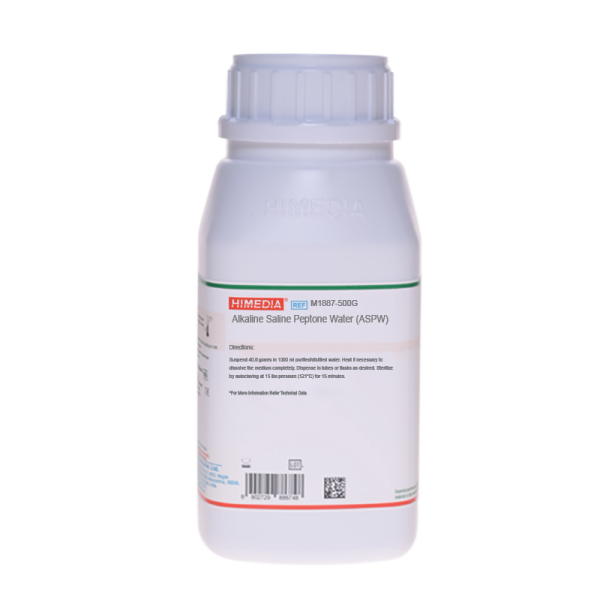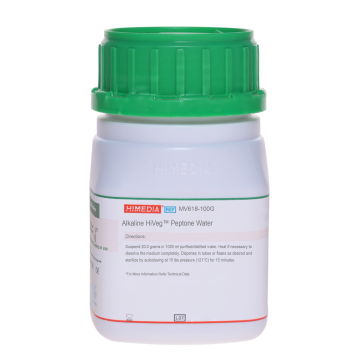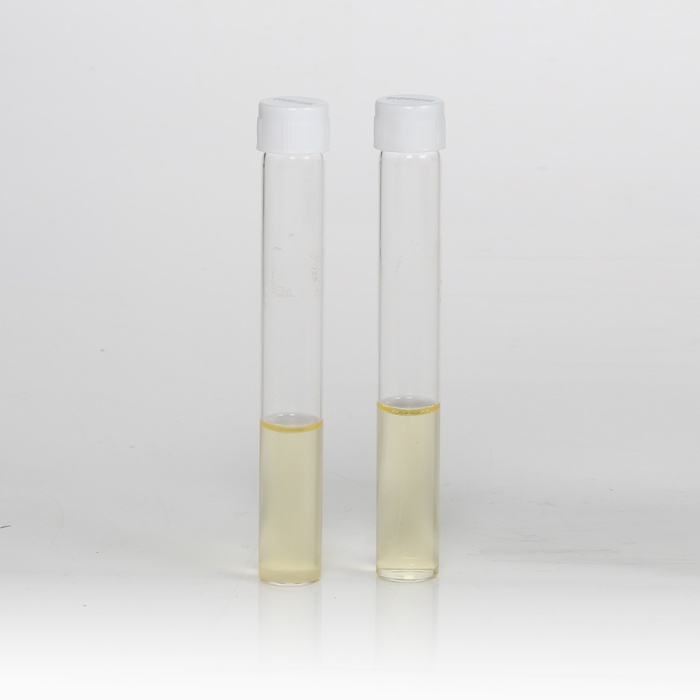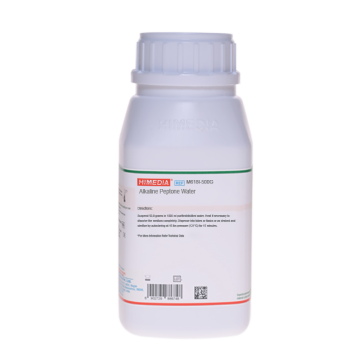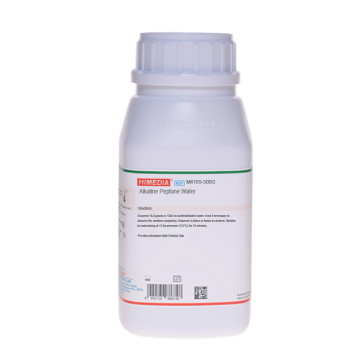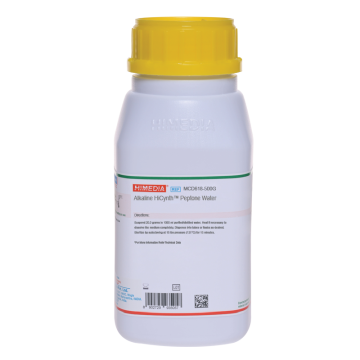 Your enquiry has been submitted
Your enquiry has been submitted
Alkaline Saline Peptone Water (ASPW)
Intended Use
Recommended for enrichment of Vibrio species from food and water samples in accordance with ISO. The composition and performance of this media are as per specifications laid down in ISO 21872-1:2017
Composition**
ISO 21872-1:2017 Specification : Alkaline Saline Peptone Water (ASPW) M1887 : Alkaline Saline Peptone Water
| Ingredients | g / L |
|---|---|
| Peptone | 20.000 |
| Sodium chloride | 20.000 |
pH after sterilization ( at 25°C) 8.6±0.2
**Formula adjusted, standardized to suit performance parameters
Directions
Suspend 40 grams in 1000 ml purified / distilled water. Heat if necessary to dissolve the medium completely. Dispense in tubes or flasks as desired. Sterilize by autoclaving at 15 lbs pressure (121°C) for 15 minutes.
Principle And Interpretation
Vibrio have played a significant role in human history. Outbreaks of cholera, caused by Vibrio cholera, can be traced back in time to early recorded descriptions of enteric infections. The Vibrios have also received the attention of marine microbiologists who observed that the readily cultured bacterial population in near-shore waters and those associated with fish and shell fish were predominantly Vibrio species (1).Vibrio species are mainly responsible for causing cholera and food poisoning in humans. Vibrio cholera causes cholerae due to the intake of contaminated food such as raw oysters. Vibrio parahaemolyticus is a major cause of food borne infections, causing food poisoning (2). Since Vibrio species naturally occur in sea water, worth special mention is their need for sodium chloride, although some species can grow with minimum sodium chloride concentration (1). The widely used media for Vibrio isolation are TCBS Agar and Alkaline Peptone Water (3). Alkaline Saline Peptone Water (ASPW) is in accordance with ISO/TS 21872-1:2017 which specifies a horizontal method for the detection of the two main pathogenic Vibrio species causing intestinal illness in humans: V. parahaemolyticus and V.cholera (4). It is applicable to products intended for human consumption and the feeding of animals, and environmental samples in the area of food production and food handling. Peptone provides carbonaceous, nitrogeneous and essential nutrients to the organisms. High concentration of sodium chloride in addition to maintaining the osmotic equilibrium also has an inhibitory action on the accompanying microflora.
Type of specimen
Food samples; Water samples
Specimen Collection and Handling
For food and dairy samples, follow appropriate techniques for sample collection and processing as per guidelines (7).
For water samples, follow appropriate techniques for sample collection, processing as per guidelines and local standards (8).
After use, contaminated materials must be sterilized by autoclaving before discarding.
Warning and Precautions
Read the label before opening the container. Wear protective gloves/protective clothing/eye protection/ face protection. Follow good microbiological lab practices while handling specimens and culture. Standard precautions as per established guidelines should be followed while handling specimens. Safety guidelines may be referred in individual safety data sheets.
Limitations
- Certain strains of Vibrio species requiring higher sodium chloride concentration may show poor growth.
- Further recovery from this enriched broth onto selective media is required.
- Biochemical characterization is carried out from pure isolates for complete identification.
Performance and Evaluation
Performance of the medium is expected when used as per the direction on the label within the expiry period when stored at recommended temperature.
Quality Control
Appearance Cream to yellow homogeneous free flowing powder
Colour and Clarity of prepared medium Light yellow coloured clear solution without any precipitate
Reaction Reaction of 4% w/v aqueous solution at 25°C. pH : 8.6±0.2
pH 8.40-8.80
Cultural Response Cultural characteristics observed after an incubation at 35-37°C for 18-24 hours.
| Organism | Inoculum (CFU) | Growth |
|---|---|---|
| Vibrio cholerae ATCC 15748 | 50-100 | luxuriant |
| Vibrio parahaemolyticus ATCC 17802 (00037*) | 50-100 | luxuriant |
Key : (*) Corresponding WDCM numbers.
Storage and Shelf Life
Store between 10-30°C in a tightly closed container and the prepared medium at 15-30°C. Use before expiry date on the label. On opening, product should be properly stored dry, after tightly capping the bottle in order to prevent lump formation due to the hygroscopic nature of the product. Improper storage of the product may lead to lump formation. Store in dry ventilated area protected from extremes of temperature and sources of ignition. Seal the container tightly after use. Product performance is best if used within stated expiry period.
Disposal
User must ensure safe disposal by autoclaving and/or incineration of used or unusable preparations of this product. Follow established laboratory procedures in disposing of infectious materials and material that comes into contact with sample must be decontaminated and disposed of in accordance with current laboratory techniques (5,6).
Reference
- Thompson et al (ed.). 2006. The Biology of Vibrios, ASM Press, chapter 1, pg
- Alcamo. E.I, 2001. Fundamentals of Microbiology, 6th ed, Jones and Bartlett Publishers, Inc. pg 254, 244.
- Clesceri, Greenberg and Eaton (ed.). 1998. Standard Method for the examination of Water and Waste water, 20th ed. American Public Health Association, Washington, D. C.
- ISO/TS 21872-1:2017. Horizontal method for the detection of the two main pathogenic Vibrio species causing intestinal illness in humans: V. parahaemolyticus and V. cholera.
- Isenberg, H.D. Clinical Microbiology Procedures Handbook 2nd Edition.
- Jorgensen, J.H., Pfaller, M.A., Carroll, K.C., Funke, G., Landry, M.L., Richter, S.S and Warnock., D.W. (2015) Manual of Clinical Microbiology, 11th Edition. Vol. 1.
- Salfinger Y., and Tortorello M.L. Fifth (Ed.), 2015, Compendium of Methods for the Microbiological Examination of Foods, 5th Ed., American Public Health Association, Washington, D.C.
- Lipps WC, Braun-Howland EB, Baxter TE,eds. Standard methods for the Examination of Water and Wastewater, 24th ed. Washington DC:APHA Press; 2023.
| Product Name | Alkaline Saline Peptone Water (ASPW) |
|---|---|
| SKU | M1887 |
| Product Type | Regular |
| Physical Form | Powder |
| Origin | Animal |
| Packaging type | HDPE |
| References | 1.Thompson et al (ed.). 200 |
| Customized Product Available | No |



